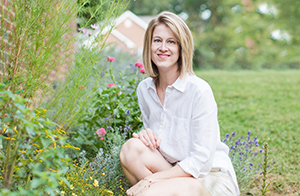Strawberries are one of the easiest and most productive plants in my small home garden. They are perennials so you don’t have to worry about planting them yearly. I grow them somewhat unconventionally to make the most of a small growing space. And, I’m also a bit lazy in not controlling the runners, so I’m here to tell you you can break the rules and have a very productive strawberry patch. Dig in to learn how to grow strawberries in a small garden…

How many strawberry plants do you need for a small garden?
Supposedly you need 6 plants per person to feed your family. My patch started with 9, but there are around 25 now (I really have no idea because they all run together), so that would meet those requirements as I have a family of 4 x 6 = 24. I can tell you that this 4’x4′ bed produces all that we can eat, plus we freeze several gallon bags per year and make about 20 jars of strawberry jam. The typical formulas would say you would need way more plants to be able to can and freeze in addition to eating them fresh. This 4’x4′ patch is maybe the hardest worker in my garden. Very satisfying as a gardener, completely unlike growing broccoli, which takes up a tremendous amount of space, takes forever to grow and then gives you one measly head of broccoli.

Strawberry seeds, bare-roots or plants?
Strawberries are typically grown from established plants or bare roots. Growing from seed is more challenging and takes a long time as they need cold stratification. I bought mine as plants, but it was because I didn’t know how cheap and easy it is to plant bare-root strawberries. I would highly recommend that you buy bare-root plants. You can get them for about $1 each or less, as compared to $5-10 for a plant at a local nursery. I have had good luck with Indiana Berry Company.

What variety of strawberry plants should you get?
How to determine which plants to get:
- Local Extension: Search the name of your local cooperative extension + strawberries to see what they recommend for strawberry plants that do well in your area. For example, here is the information from my local extension about what does well in southwest Virginia.
- State-by-state guide: Here is a guide to recommended strawberry varieties by state.
- Local Nursery: Also, it’s probably a safe bet that whatever plants they are selling at local nurseries are plants that do well in your area. But, you’re going to buy bare-root plants to save money, right?!?
Once you know what variety is good in your area, you need to know which kind of strawberry plant it is so that you know what to expect and know how to care for it.
There are three kinds of strawberry plants:
- June Bearing – Just as the name implies, it produces in June, and is the heaviest producer of the three, but you get the crop all at once and then it’s done.
- Everbearing – One main crop in June and another smaller one in the fall.
- Day Neutral – A main crop in June and then it produces smaller amounts throughout the season.
I have Ozark Beauty, which is everbearing, but mine behaves like a Day Neutral plant.
How to plant strawberries
You are supposed to plant strawberries in mounded rows, but in my small garden, I planted 9 plants in 3 rows in a 4×4 bed. (It is now the strawberry jungle.) This is the slightly unconventional aspect of how I grow strawberries because I have a small garden. It’s either this or nothing for me. So, sometimes, it’s worth it to eschew the garden rules and make things work for you.

You want to plant them with the crown partially buried and partially above ground. See the graphic below from Virginia Cooperative Extension.


After planting, you should pinch the blooms off of June Bearers for the whole first year and pinch off blooms until June for the other two kinds. This allows the plant to focus on root growth before setting fruit and giving you a better harvest the next year. However, this is not essential and if you get excited seeing those blooms and a few berries the first year, go for it!
Caring for strawberry plants
Fertilizing Strawberries
Hmmm…fertilizing is still one thing that I never feel confident about because there are so many schools of thought out there that are conflicting. And, it’s hard to find good sources when you search and the same websites pop up for gardening no matter what you search – bhg.com, thespruce.com, etc. Nah, I’m not interested in those big sites where they write about everything and have content creators doing it. I want to hear from the real gardeners, the universities, the researchers. So, I always recommend searching for information from your local extension service or university.
You can fertilize the plants in a variety of ways. Sometimes I only use compost, sometimes I use a granular fertilizer and sometimes I use liquid (AgroThrive Fruit and Flower 3-3-5).
As for when to fertilize, this is where it gets confusing. Some say that you should fertilize right before they come out of dormancy in late winter and again in mid-summer to early fall. And, others, like Michigan State University say:
Established strawberries should be fertilized once per year after the final harvest. Spring fertilization is not recommended because it can result in soft berries and overly vigorous growth that can increase the incidence of disease.
Pulling strawberry runners or not?
So, you’re supposed to pull the runners of strawberry plants. They are kind of like spider plants where there is a long runner and then a new plant grows. The reason is so that all of the energy can go into the main plant. I didn’t do that and I’m not sorry about it. I have a big strawberry jungle and while a little challenging to harvest from, it is a top performer in my garden. Technically I have no idea how many plants I have now. The plants started spilling over the edge of my raised bed and growing in the path. I decided to let them because I have the space and I want more berries! (Also, what? they grow just as well in my hardened, compacted, unfertilized garden path?!?)
This is what my strawberry patch looked like the second year!

Pruning
At the end of the growing season, you can remove the dead stems, leaves and other debris and cut the runners. I do some of this in late fall and then again in late winter/early spring. You can also transplant some of the new plants at either time – fall or early spring.
Replacing plants
You are supposed to replace plants every 3 years or so. When I first heard this, I was thinking you have got to be kidding me. Perennial, huh? What’s the point of getting this all established and then as soon as it is, you have to start over? I am at the point now where I should do it, however, I have so many new plants from letting things grow wild that I don’t only have the 3 to 4-year-old plants, and how the heck would I know which ones are old? So again, I’m going to be the stubborn gardener and ignore this and see how it plays out. I think my garden is essentially doing this task for me and when I prune the dead, that’s exactly what I’m doing without it having to be a sweeping change.
Overwintering strawberries
Years after having strawberries in my small garden, I read that you should mulch them for the winter with hay or leaves. Oops. I never did that and they have been just fine, so I’m going to be lazy and keep on not doing it.

However, in the early spring, once the plants start blooming and there will be a hard frost, you need to protect the plants from cold. Of course they have the uncanny ability to always bloom before the last hard frost. Sigh.
The picture below was in March during a hard freeze and the plants were blooming. I didn’t have hoops on that bed yet, so I used tomato cages in the center of the bed. And, I didn’t have frost cloth because I was already using what I had on other beds, so I used a sheet. It doesn’t have to be fancy. However, I do love having the hoops and it’s easy to set up. See my guide here on how set up hoops and row covers on a budget.

Strawberry Pests
The biggest pests I have had to deal with are slugs, pill bugs and birds.
Slugs and Pill bugs
For slugs, I have used beer traps. For slugs and pill bugs, I have used Sluggo. I don’t like using Sluggo even though it’s supposed to be safe for earthworms, but one season I caved and used it.


Birds
One year I put insect cloth over the whole bed to prevent birds from pecking at the berries. Typically, I am of the mindset to share with them as long as it isn’t too bad, but too many were going to waste. This solved the problem. It made it slightly more inconvenient for me to have to pull the cloth off to harvest, but no big deal.

Grow with me
See my other garden or wildlife posts.
Get new posts in your inbox by subscribing.
Follow on Instagram.






12 Comments
Thank you. Love your article. Got some good info out of it.
Hi Steve, Thank you. Good luck with growing strawberries.
[…] Consideration: Hot summers can stress strawberry plants if planted in spring. Fall planting gives them time to root before heat […]
[…] @whitneyanderick […]
[…] @whitneyanderick […]
[…] the words of Whitney and Erick, choosing the right variety can mean the difference between one good week of berries and several […]
[…] the words of Whitney and Erick, choosing the right variety can mean the difference between one good week of berries and several […]
[…] the words of Whitney and Erick, choosing the right variety can mean the difference between one good week of berries and several […]
[…] the words of Whitney and Erick, choosing the right variety can mean the difference between one good week of berries and several […]
[…] the words of Whitney and Erick, choosing the right variety can mean the difference between one good week of berries and several […]
[…] the words of Whitney and Erick, choosing the right variety can mean the difference between one good week of berries and several […]
[…] care is key to thriving strawberry plants in small spaces. Water regularly, keeping the soil moist but not waterlogged. In hot weather, you might need to […]